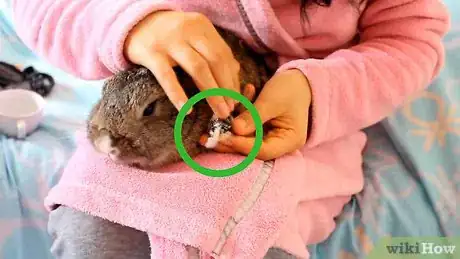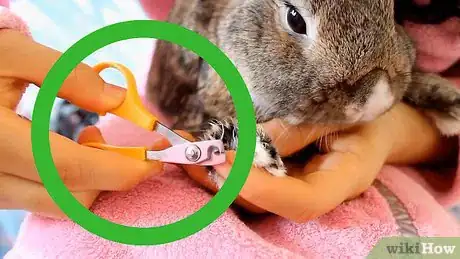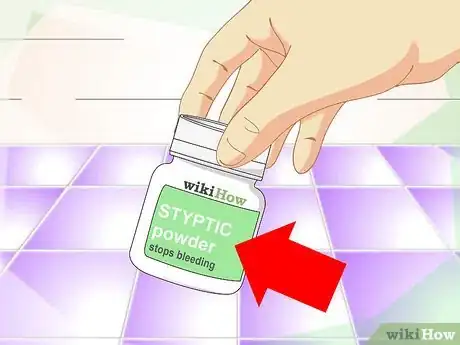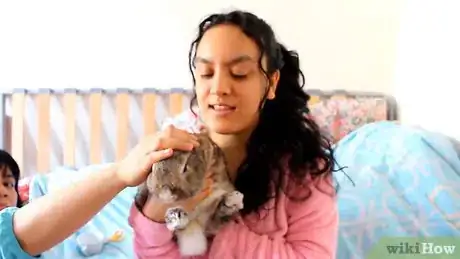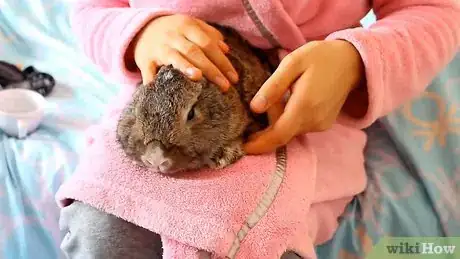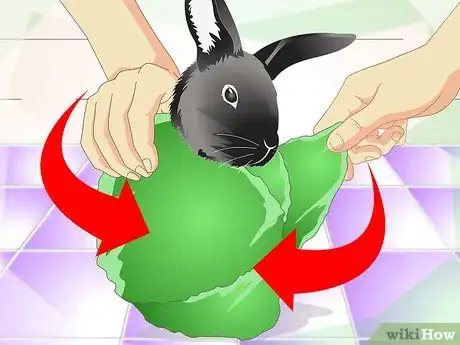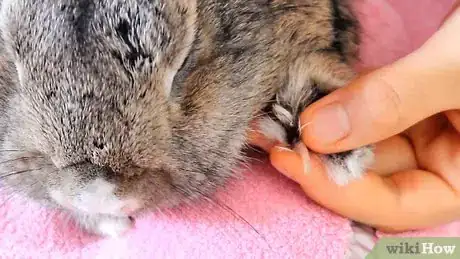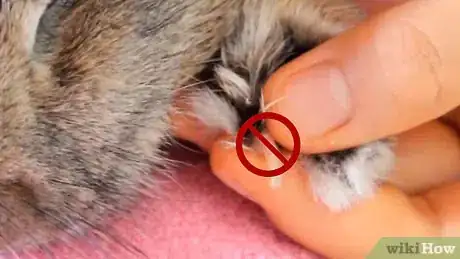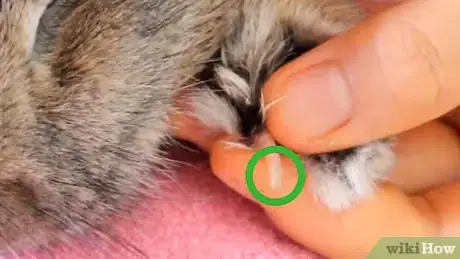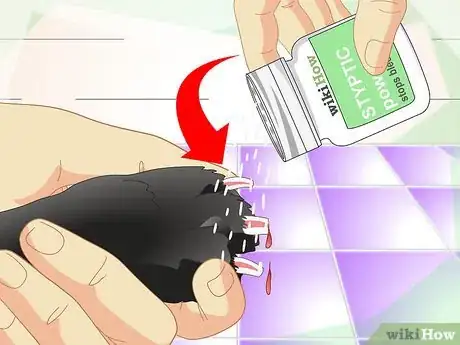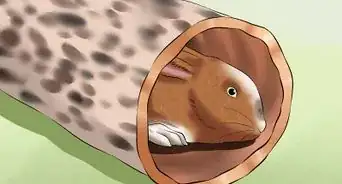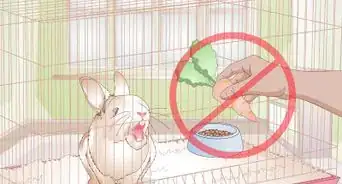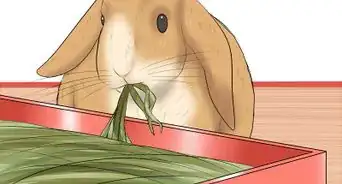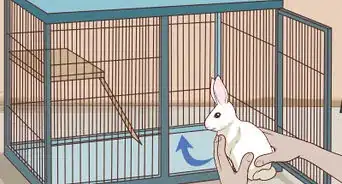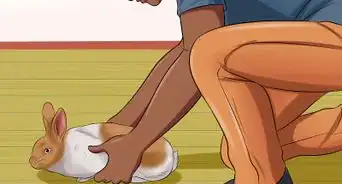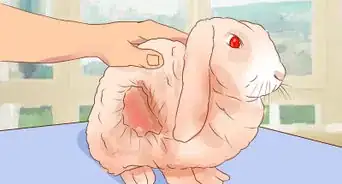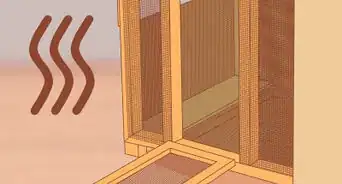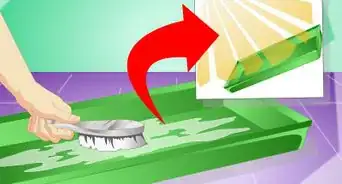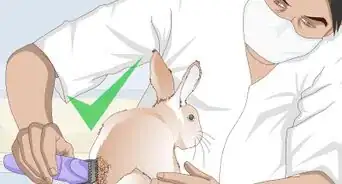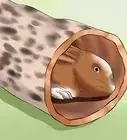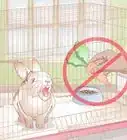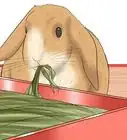This article was co-authored by Pippa Elliott, MRCVS. Dr. Elliott, BVMS, MRCVS is a veterinarian with over 30 years of experience in veterinary surgery and companion animal practice. She graduated from the University of Glasgow in 1987 with a degree in veterinary medicine and surgery. She has worked at the same animal clinic in her hometown for over 20 years.
wikiHow marks an article as reader-approved once it receives enough positive feedback. In this case, 100% of readers who voted found the article helpful, earning it our reader-approved status.
This article has been viewed 292,816 times.
Trimming claws is a necessary part of keeping your rabbit healthy. Trim nails on a regular basis to prevent them from overgrowing, tearing off, and even possibly impacting the rabbit’s ability to hop. Long nails are a hazard to your rabbit’s health! Some people prefer to take their rabbits to a vet or another professional, but you can easily cut claws at home with patience and practice.
Steps
Preparing to Cut
-
1Inspect your rabbit's nails. All rabbit's nails grow at different paces, so there isn't a concrete rule on how often nails should be clipped. Generally, you should inspect your rabbit's nails once a month. If the nail curves at all, it is too long and it needs to be clipped. If you can hear your rabbit's nails hitting the floor when he hops, this is another indication that it's time to clip his nails.
- Wild rabbits don't need pedicures — their claws wear down from digging, foraging, and other routine tasks. Domestic rabbits, however, do not use their claws so much, and it is your job to make sure that they don't grow too long or sharp.[1]
- Rabbits have four nails on their rear feet. On their front paws, they have the four toenails, and then the dewclaw. The dewclaw sits slightly higher than the other toenails, on the inside of the paw.
-
2Choose a nail clipper. People typically use both dog- and cat-claw trimmers to cut rabbit claws. Either option will do the job, so your choice is mostly a matter of personal preference. Make sure to choose a clipper that matches the size of your rabbit: if you have a very small rabbit, it will be much easier to cut its claws with a small set of clippers. Some nail clippers include a safety to ensure that you don't cut too much.
- Scissor-style clippers. These clippers are usually used to trim cat nails. As the name suggests, they look and work just like scissors. You may enjoy the freedom of motion and movement these clippers offer over the next style.
- Guillotine-style clippers. These clippers are typically used for dogs because they can handle thicker nails. Much like a guillotine, these clippers have a circular hole into which you slip the nail. Squeeze the handle, and a blade cuts the nail. Guillotine clippers may give you slightly more control than the scissors.
Advertisement -
3Keep a styptic on hand to stop bleeding. It's possible that if you cut your rabbit's nails too short, they will bleed a little. There is a blood vessel—called a quick—inside each of your rabbit's claws, and it may begin to bleed profusely if snipped. Styptic powder promotes clotting, so it is good to have some on hand when trimming your rabbit's nails.[2] To stop the bleeding, simply grab a pinch of styptic powder and dab it on the source of the bleeding You can also use plain baking flour as a makeshift coagulant.[3]
- You can buy styptic pencils or styptic powder in most drugstores. Styptic pencils make it easy to quickly deploy the anti-bleeding substance, and they may be easier to find than pure styptic powder.
-
4Ask someone to help out. If you've never cut a rabbit's claws before, it might be hard for you to simultaneously restrain the animal and clip the nails. A partner can stabilize the rabbit while you work on the nails. If no one is available, you can still cut the rabbit's nails by yourself.
Restraining Your Rabbit
-
1Calm your rabbit. If you rush the procedure, you might stress the rabbit out. If your rabbit is uneasy, it may panic and thrash around while you try to restrain it or trim it. Hold your rabbit in your lap, gently, and stroke it for a while before you start the cutting process. Wait for your rabbit to relax — it should be still, peaceful, and breathing deeply. If its eyes are closed or partially closed, it's probably comfortable.
-
2Gently restrain your rabbit. It's important to keep your rabbit still while you trim his nails; some rabbits may panic and thrash about if they feel threatened. Be gentle, firm, and reassuring to keep your rabbit calm and immobile. Rabbits are fragile, and you can hurt them if you restrain them too roughly. Hold him in place, and only apply pressure if he starts to struggle or tries to get away.
- Never press down on the rabbit's back or spine. It is easy to break a rabbit's back — it does not take much.
- If your rabbit panics and struggles, apply moderate pressure to his flanks. The flanks include the sides of his body and the haunches of his legs. This pressure mimics being squeezed together with other rabbits in a burrow, and it can help to calm a stressed-out rabbit.
-
3Hold the rabbit against your body. Place the rabbit on the edge of a table, then use your forearm to hold him against your body. You generally need to sit while doing this. Cup your hand underneath his chest, and use your elbow to keep his hindquarters pressed against you. Make sure your rabbit is comfortable in this position. Only hold him tightly if he begins to struggle.[4]
- Try cradling your rabbit in your lap the way you'd hold a baby. Rest the rabbit's back upon your legs, and lay its head in the crook of your elbow. Use one hand to hold out a paw, and the other hand to clip.
-
4Wrap your rabbit in a clean towel. Cover up everything but the head, and make sure not to trap the ears. This will help keep the rabbit still and comfortable. . Once the rabbit is wrapped up, pull out one foot at a time and clip the nails. Place each paw back inside the towel before taking out the next one.
- Hold the rabbit on your lap, or lay him onto a non-slippery surface: lay a towel or mat on top of a sofa or table. The important thing is that your rabbit is calm, comfortable, and immobile.
- If your rabbit is afraid of heights, sit on the floor with him. You'll be able to tell that he is afraid if he squirms and visibly panics when you lift him to a high place.
-
5Find someone else to hold the rabbit. If you wrap your rabbit in a towel, your helper can restrain it on a surface by holding it gently on each side of its body. You may also ask your helper to pick up your rabbit and hold it while you do the clipping. If your rabbit has a habit of squirming, this may not be the best choice, because your partner could get scratched and drop him. This should work fine, however, if your rabbit tends to behave calmly around people.
Clipping the Claws
-
1Do not cut the blood vessel inside each claw. Like dogs and cats, rabbits have a blood vessel (the quick) inside each of their claws. If you cut the quick, your rabbit will bleed painfully and profusely — so make sure that you identify the blood vessel before you start chopping away. The quick usually looks like a red or dark spot inside the root of the nail.
- If your rabbit has white or clear nails, you should be able to find the quick without much trouble. The blood vessel will be red or pink, so simply cut the white part of the nail above the red section.
- If your rabbit has darker-colored nails, shine a flashlight on the nails to find the blood vessel. The quick should be a visible dark spot inside an otherwise translucent nail. Make note of the quick's location, and only cut the nail above that spot.[5]
- If you still can't find the quick, you can estimate its location by feeling the claw. Pick a location about halfway down the claw, and use the dull end of your clippers to press down firmly. If your rabbit tries to pull his paw back or struggles, you're probably pressing the blood vessel. Try again slightly further up the claw toward the point. If the rabbit doesn't react, it's probably safe to start cutting from that point.
-
2Trim only the tip of each claw. It is better to make tiny, frequent cuts than to cut too much once the nails grow long. Clip your rabbit's claws every 4-6 weeks, depending on how active it is.
-
3Cut the claws. Make sure that your rabbit is properly restrained. Start with the front nails: push away the fur around a claw, locate the quick, and determine where to cut. Make the cut quickly and neatly, with the least amount of movement possible. Clip the white or translucent tip of each claw, well above the quick. Before you clip, apply a slight pressure as a "test clip" — if the rabbit recoils its paw, there's a good chance that you're about to clip the blood vessel.
- You may need to flip your bunny over onto its back to trim the rear paws. Do this very carefully so that you don't hurt or disturb the rabbit. Bunnies with enough exercise may not need their back nails trimmed — hopping, digging, and general activity wear the nails down naturally.
- Remember to clip the dewclaw on each of the front paws. If the dewclaw grows too long, it may get caught on something and hurt your rabbit.
-
4Repeat the process for each nail. Find the quick and clip the nail for each paw until you're finished. Be methodical, and take your time. Take a break between feet if your rabbit is struggling or the procedure is taking a while. This is especially important if you are using a towel for restraint — unwrap your rabbit for a few minutes to keep it from overheating. Try using treats as a reward to make your rabbit more comfortable.
-
5Use styptic powder on your rabbit's nails, if necessary. Mistakes happen, even if you've done your best to locate the blood vessels in the nail. Rabbits are prone to sudden movements, and you may accidentally lop off more than you plan to. Don't worry — act quickly and calmly, and the cut will heal.
Expert Q&A
Did you know you can get expert answers for this article?
Unlock expert answers by supporting wikiHow
-
QuestionHow do I stop feeling anxious when cutting a rabbit's claws?
 Pippa Elliott, MRCVSDr. Elliott, BVMS, MRCVS is a veterinarian with over 30 years of experience in veterinary surgery and companion animal practice. She graduated from the University of Glasgow in 1987 with a degree in veterinary medicine and surgery. She has worked at the same animal clinic in her hometown for over 20 years.
Pippa Elliott, MRCVSDr. Elliott, BVMS, MRCVS is a veterinarian with over 30 years of experience in veterinary surgery and companion animal practice. She graduated from the University of Glasgow in 1987 with a degree in veterinary medicine and surgery. She has worked at the same animal clinic in her hometown for over 20 years.
Veterinarian Your anxiety is probably caused by a fear of hurting the rabbit or clipping in the wrong place. Respect the anxiety, and have an expert (such as a vet, vet tech, or groomer) show you exactly where to cut the claw and how to hold the rabbit safely. This should increase your confidence. However, clipping your own pet's nails can be nerve wracking, so if this isn't something you feel comfortable with, perhaps ask a friend to help you or have him do it.
Your anxiety is probably caused by a fear of hurting the rabbit or clipping in the wrong place. Respect the anxiety, and have an expert (such as a vet, vet tech, or groomer) show you exactly where to cut the claw and how to hold the rabbit safely. This should increase your confidence. However, clipping your own pet's nails can be nerve wracking, so if this isn't something you feel comfortable with, perhaps ask a friend to help you or have him do it. -
QuestionWe use a small side cut pliers to cut baby pigs' teeth, can that style side cut be used for this as well?
 Pippa Elliott, MRCVSDr. Elliott, BVMS, MRCVS is a veterinarian with over 30 years of experience in veterinary surgery and companion animal practice. She graduated from the University of Glasgow in 1987 with a degree in veterinary medicine and surgery. She has worked at the same animal clinic in her hometown for over 20 years.
Pippa Elliott, MRCVSDr. Elliott, BVMS, MRCVS is a veterinarian with over 30 years of experience in veterinary surgery and companion animal practice. She graduated from the University of Glasgow in 1987 with a degree in veterinary medicine and surgery. She has worked at the same animal clinic in her hometown for over 20 years.
Veterinarian
-
QuestionHow do I get the rabbit's legs out of the towel?
 Pippa Elliott, MRCVSDr. Elliott, BVMS, MRCVS is a veterinarian with over 30 years of experience in veterinary surgery and companion animal practice. She graduated from the University of Glasgow in 1987 with a degree in veterinary medicine and surgery. She has worked at the same animal clinic in her hometown for over 20 years.
Pippa Elliott, MRCVSDr. Elliott, BVMS, MRCVS is a veterinarian with over 30 years of experience in veterinary surgery and companion animal practice. She graduated from the University of Glasgow in 1987 with a degree in veterinary medicine and surgery. She has worked at the same animal clinic in her hometown for over 20 years.
Veterinarian Once the rabbit is wrapped, it's usually possible to elect a leg to uncover and gently loosen the towel over that leg in order to wriggle it free. Sometimes this may mean you need to unpick part of the wrapping until you can reach through the folds to grasp a paw and expose it. Don't worry if the towel loosens, just cover the rabbit's eyes with part of the towel and hug the rabbit to you firmly. This reassures the rabbit and makes it less likely to scrabble.
Once the rabbit is wrapped, it's usually possible to elect a leg to uncover and gently loosen the towel over that leg in order to wriggle it free. Sometimes this may mean you need to unpick part of the wrapping until you can reach through the folds to grasp a paw and expose it. Don't worry if the towel loosens, just cover the rabbit's eyes with part of the towel and hug the rabbit to you firmly. This reassures the rabbit and makes it less likely to scrabble.
References
- ↑ http://www.petco.com/Content/ArticleList/Article/19/21/910/Nail-Trimming.aspx
- ↑ http://www.wisegeek.org/what-is-styptic-powder.htm
- ↑ http://myhouserabbit.com/rabbit-care/clipping-your-rabbits-nails/
- ↑ http://rabbit.org/how-to-trim-your-rabbits-nails/
- ↑ http://pets.stackexchange.com/questions/3105/do-i-need-to-trim-a-rabbits-nails
- Videos provided by ArtAndBeautyFreak
About This Article
To cut a rabbit’s claws, start by either holding your rabbit securely against your body, wrapping it in a towel, or having someone else hold your rabbit to make sure it doesn’t squirm around too much. Next, find the blood vessel inside each claw, which will be red or pink, and make sure to cut only the white part above this section to avoid drawing blood. Then, push away the fur around the front claw and make quick, neat cuts. Repeat this process on the back claws, and plan to trim your rabbit’s claws every 4-6 weeks to keep them manageable. For more tips from our Veterinary co-author, including how to use styptic powder on your rabbit’s nails if you hit a blood vessel, keep reading!
